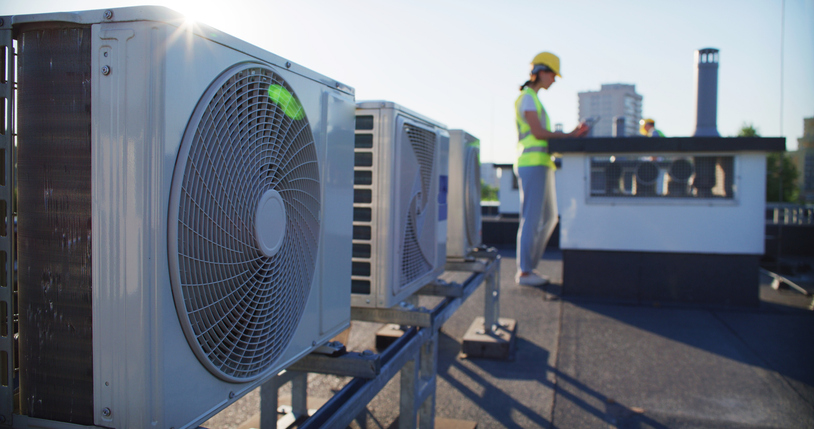In high-demand HVAC environments – particularly within industrial, healthcare, and commercial sectors – system integrity and air handling efficiency are critical. Yet one of the most persistent and underestimated threats to HVAC performance is biofoul buildup. This silent disruptor can compromise air quality, reduce system efficiency, and drastically increase operational costs.
As facilities face increasing pressure to meet stringent air quality regulations while maintaining energy-efficient operations, understanding and mitigating biofoul buildup becomes a strategic necessity. One of the most scientifically validated and cost-effective solutions to this challenge is the implementation of UV-C technology.
Understanding Biofoul Buildup in HVAC Systems
Biofoul buildup refers to the accumulation of biological contaminants – primarily bacteria, mould, fungi, and microbial slime – on moist HVAC system surfaces. It most commonly occurs on evaporator coils, drain pans, and interior duct surfaces where moisture, darkness, and organic matter create ideal breeding grounds for microbial colonies.
This microbial proliferation forms a viscous biofilm that adheres to surfaces and accelerates contaminant deposition. In environments such as hospitals, food-processing facilities, and pharmaceutical production areas, biofoul buildup is not only a performance concern but also a compliance and safety risk.
The Impact of Biofoul Buildup on System Performance
From an engineering perspective, the consequences of biofoul buildup extend well beyond aesthetics or hygiene. Biofilms act as insulators on coil surfaces, impeding heat exchange efficiency. The system must work harder to achieve the desired thermal transfer, which translates into elevated energy consumption and increased load on HVAC components.
Key technical impacts include:
- Increased pressure drop across coils due to airflow resistance.
- Reduced cooling capacity and ineffective humidity control.
- Accelerated corrosion of metallic components through microbial-induced degradation.
- Shortened equipment lifespan due to elevated mechanical stress and overheating.
In short, biofoul buildup drives up both direct and indirect costs, from higher energy bills to premature equipment replacement and regulatory penalties for air quality violations.
How UV-C Technology Mitigates Biofoul Buildup
UV-C (ultraviolet-C) light operates within the 200–280 nanometer wavelength range, which is proven to disrupt the DNA and RNA of microorganisms, rendering them inactive and unable to reproduce. When applied correctly in HVAC systems, UV-C technology serves as a non-chemical, continuous treatment method for reducing biofoul buildup on critical surfaces.
Two primary UV-C deployment strategies are effective in HVAC environments:
- Coil Surface Irradiation: UV-C lamps are installed to continuously illuminate the coil surfaces, preventing the establishment of microbial colonies and maintaining coil cleanliness.
- Airstream Disinfection: UV-C units are placed within the air handling unit or ducts to target airborne microorganisms, enhancing overall system hygiene while supporting compliance with supplemental air purification standards.
Importantly, while UV-C systems do not “sanitize” or “purify” air in the regulatory sense, they supplement sanitation efforts by reducing airborne contaminants and inhibiting the biological conditions that foster biofoul buildup.
Why Air Sniper Offers a Technically Superior Solution
Not all UV-C systems are engineered equally. Air Sniper’s UV-C technology sets itself apart through a blend of scientific validation, durability, and engineering-grade performance.
Key advantages of Air Sniper include:
- Extended Lamp Life: With an industry-leading 55,200-hour lamp lifespan, Air Sniper systems operate continuously for over 6 years, dramatically reducing maintenance frequency and associated labor costs.
- Energy Efficiency: Optimized for minimal power draw without compromising UV output, Air Sniper systems contribute to lower HVAC operational energy loads.
- Industrial Durability: Constructed to withstand extreme temperatures (from -20°C to +100°C), Air Sniper units are built for demanding environments where standard components fail.
- Compliance and Certification: Air Sniper solutions meet cETLus, UL, CSA, and EPA registration standards, supporting regulated industries seeking proven, auditable air quality measures.
- Supplemental Air Purification: Fully aligned with Health Canada and PMRA requirements, Air Sniper units are positioned as compliant, safe technologies for reducing airborne contaminants and inhibiting microbial growth.
Where conventional filtration falls short, particularly against surface-bound biofilms, Air Sniper’s UV-C implementation ensures that biofoul buildup is continuously controlled at the source.
Seamless Integration and System Scalability
Air Sniper products are designed with modularity and interoperability in mind. Whether retrofitting an existing HVAC system or designing a new installation, the systems allow for:
- Scalable deployment, from small coil applications to expansive ducted systems.
- BAS (Building Automation System) compatibility, allowing operators to monitor UV system health and performance via centralized dashboards.
- Minimal disruption during installation, thanks to compact form factors and standardized mounting configurations.
This ensures facility engineers can implement UV-C solutions without requiring significant HVAC system redesign or downtime.
Conclusion: Engineering Out Biofoul Buildup
For engineers and facility managers seeking long-term performance, efficiency, and regulatory alignment, addressing biofoul buildup is no longer optional – it’s operationally imperative.
By leveraging scientifically validated UV-C systems like those engineered by Air Sniper, organizations can prevent the microbial accumulation that leads to mechanical inefficiencies, air quality violations, and escalating maintenance costs.
Through precision engineering, robust component design, and an unwavering focus on compliance, Air Sniper provides the industry’s most effective defense against biofoul buildup in HVAC systems, ensuring your infrastructure operates cleanly, efficiently, and reliably for years to come.

